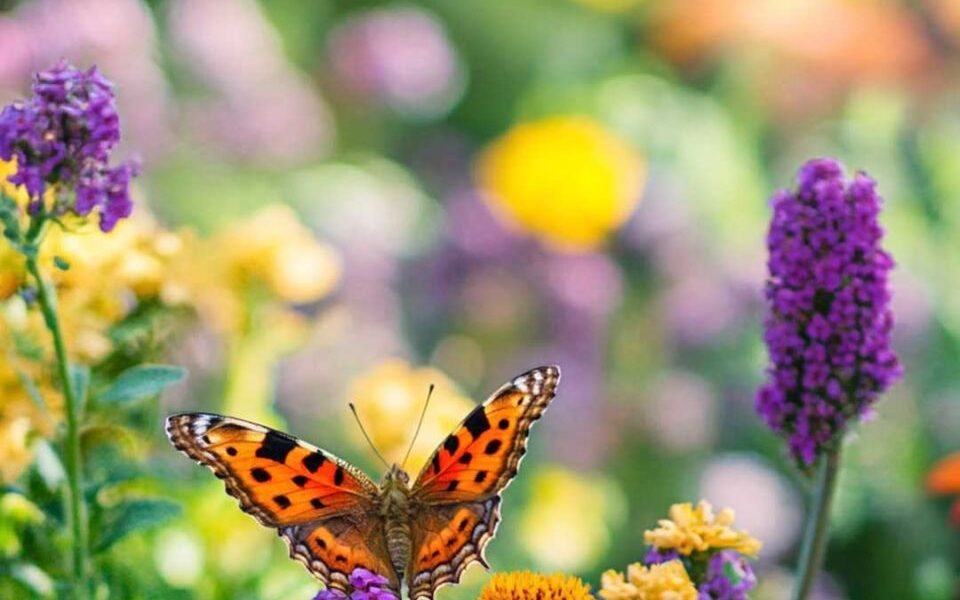Transforming your backyard into a butterfly haven is not just a visually captivating and rewarding endeavor; it is also a vital contribution to preserving and supporting local ecosystems. Butterflies are not only beautiful creatures to observe, but they also play a significant role in pollination. They help plants reproduce, which contributes to maintaining the balance of nature. By creating a butterfly-friendly garden, you can attract these delicate insects and, in turn, support biodiversity while enjoying their vibrant colors and graceful movements. This article will guide you through the steps to select the right plants and create an environment that both attracts and sustains butterflies.
Understanding the Needs of Butterflies
To effectively attract and sustain butterflies, it is essential to understand their basic needs. Butterflies rely on several key factors to thrive, including food, safe habitats, and favorable environmental conditions. Below are the fundamental needs of butterflies to keep in mind when creating your butterfly haven:
- Nectar-Rich Flowers: Butterflies primarily feed on nectar from flowers. They need an ample supply of nectar-rich plants that bloom from spring to fall.
- Host Plants for Egg Laying: Butterflies require specific plants to lay their eggs, known as host plants. These plants serve as food sources for caterpillars once they hatch.
- Safe Habitats: To thrive, butterflies need a safe, sheltered environment. Pesticides, chemicals, and harsh environments can harm butterflies, so ensuring a pesticide-free garden is critical.
- Sunny Spots: Butterflies are cold-blooded and depend on the sun for warmth. They need sunny spots where they can bask and regulate their body temperature.
- Shallow Water Sources: Butterflies need access to water, particularly shallow puddles or birdbaths, where they can drink or obtain essential minerals.
- Mud Puddles for Minerals: Many butterfly species need mud puddles to absorb minerals essential for their survival, so incorporating a mud puddle or two in your garden is beneficial.
By providing all of these essential elements, your garden will attract a variety of butterfly species, creating a healthy, thriving habitat.
The Importance of Native Plants
Native plants are the cornerstone of any successful butterfly garden. These plants have evolved alongside local butterfly species, and they provide the specific nutrients and habitat conditions that native butterflies require. There are several benefits to incorporating native plants into your butterfly garden:
- Supporting Local Wildlife: Native plants are a food source for native insects, including butterflies, and they help support other wildlife, such as birds and bees.
- Adapted to Local Conditions: Native plants are naturally suited to your region’s climate, soil, and weather conditions, making them easier to grow and maintain.
- Pest Resistance: Native plants are more resilient to local pests and diseases compared to non-native varieties. This reduces the need for chemical interventions, ensuring a safer environment for butterflies and other beneficial insects.
- Biodiversity Preservation: Planting native species helps protect and preserve local ecosystems, contributing to biodiversity and the health of your garden.
By choosing native plants, you can create a sustainable, low-maintenance garden that supports both local wildlife and the environment.
Choosing the Right Plants for Your Region
When selecting plants for your butterfly garden, it is essential to choose species that are well-suited to your region’s climate, soil type, and growing conditions. Research the local butterfly species in your area and the types of plants they prefer for feeding and egg-laying. Factors to consider when choosing plants include:
- Sunlight: Butterflies are drawn to sunny spots. Choose plants that thrive in the amount of sunlight your garden receives, whether it’s full sun or partial shade.
- Soil Type: The type of soil in your garden will influence the types of plants that will grow best. Whether you have sandy, loamy, or clay-heavy soil, ensure the plants you choose are suited to your soil conditions.
- Water Availability: Make sure the plants you select match the moisture level your garden can provide. Some butterfly-friendly plants prefer dry conditions, while others thrive in moist, well-drained soil.
For guidance, local gardening centers, botanical gardens, or extension services can provide valuable information on the best plants for your specific region.
Planting for Continuous Bloom
A butterfly garden should provide a continuous supply of nectar throughout the growing season. To achieve this, plant a variety of flowering plants that bloom at different times. This ensures butterflies will have a food source available from spring to fall. Consider the following:
- Early Season Bloomers: Plants like crocuses and early-blooming asters provide nectar when butterflies are emerging in the spring.
- Mid-Season Bloomers: Plants like coneflowers, lavender, and butterfly bushes will bloom in the summer, offering a steady nectar source during the warmer months.
- Late Season Bloomers: Asters, goldenrod, and other late-season flowers bloom in the fall, providing critical nectar for butterflies that migrate or prepare for winter.
By selecting a variety of plants that bloom at different times, you’ll create a year-round butterfly haven.
Creating a Diverse Habitat
A diverse garden with a mix of flowering plants, shrubs, and trees will attract a wide range of butterfly species. This diversity mimics natural ecosystems and supports a healthy butterfly population. Additionally, providing both nectar plants for adult butterflies and host plants for caterpillars ensures the life cycle of butterflies is supported in your garden. Some butterfly species are picky about the types of plants they use for egg-laying, so be sure to include the right host plants for your region’s native butterfly species.
Providing Water Sources
Water is crucial for butterflies, especially during hot weather. Shallow water sources are ideal, as butterflies can drink from them without getting submerged. There are several ways to provide water in your garden:
- Shallow Birdbaths: Fill a birdbath with shallow water, and place stones or pebbles in it so butterflies can perch and drink without drowning.
- Dishes with Sand and Water: Create shallow dishes filled with sand and water. The sand helps provide essential minerals that butterflies need, and the water offers hydration.
- Mud Puddles: Butterflies often visit mud puddles to obtain minerals that are important for reproduction. You can create a small mud puddle by digging a shallow depression in the soil and keeping it moist.
Make sure that any water sources are clean and accessible, as standing, dirty water can be a breeding ground for mosquitoes.
Avoiding Pesticides and Chemicals
Pesticides and chemical treatments can be harmful to butterflies and other beneficial insects. To maintain a healthy butterfly habitat, it’s essential to avoid using pesticides, herbicides, or synthetic fertilizers. Instead, focus on natural pest control methods, such as:
- Encouraging Predator Insects: Ladybugs, lacewings, and predatory beetles are natural predators of common garden pests and can help maintain a healthy balance in your garden.
- Companion Planting: Certain plants, such as marigolds and garlic, can deter pests naturally, reducing the need for chemical interventions.
- Organic Fertilizers: Use compost or organic fertilizers to provide essential nutrients to your plants without harming butterflies or other beneficial insects.
Healthy, diverse gardens are naturally more resilient to pests, so by fostering biodiversity, you can reduce your garden’s reliance on chemicals.
15 Plants to Attract Butterflies
To help you create the perfect butterfly haven, here is a list of 15 plants known to attract butterflies. These plants offer nectar, shelter, and host plants for caterpillars, making them perfect additions to your garden.
- Milkweed (Asclepias spp.) – Essential for Monarchs, milkweed provides nectar and serves as the sole host plant for their larvae.
- Butterfly Bush (Buddleja spp.) – With long, fragrant flower spikes, butterfly bush attracts a wide range of butterflies.
- Coneflower (Echinacea spp.) – A hardy perennial that offers nectar-rich blooms, perfect for attracting pollinators.
- Lantana (Lantana spp.) – Lantanas are colorful, drought-tolerant plants that butterflies love for their abundant nectar.
- Black-Eyed Susan (Rudbeckia spp.) – These hardy plants with bright yellow flowers are perfect for attracting butterflies and other pollinators.
- Joe-Pye Weed (Eutrochium spp.) – A tall, nectar-rich plant that attracts butterflies with its pinkish-purple blooms.
- Zinnia (Zinnia spp.) – Easy to grow and available in a variety of colors, zinnias are a favorite nectar source for butterflies.
- Aster (Symphyotrichum spp.) – A late-season bloomer, asters provide nectar for migrating butterflies in the fall.
- Verbena (Verbena spp.) – A low-growing plant with small, colorful flowers that butterflies find irresistible.
- Phlox (Phlox paniculata) – With fragrant, colorful flowers, phlox attracts butterflies and adds beauty to your garden.
- Lavender (Lavandula spp.) – Aromatic and butterfly-friendly, lavender attracts pollinators and deters pests.
- Salvia (Salvia spp.) – Its tubular flowers are loved by butterflies and hummingbirds alike.
- Marigold (Tagetes spp.) – Cheerful, easy-to-grow flowers that attract butterflies and repel harmful insects.
- Bee Balm (Monarda spp.) – Known for its fragrant, tubular flowers, bee balm attracts butterflies, bees, and hummingbirds.
- Yarrow (Achillea spp.) – Drought-tolerant and rich in nectar, yarrow is an excellent choice for attracting butterflies.
Tips for Maintaining Your Butterfly Garden
Maintaining your butterfly garden is key to its success. Regular care includes:
- Deadheading Spent Flowers: Regularly remove spent flowers to encourage new blooms and extend the nectar supply.
- Watering: Ensure your plants receive adequate water, especially during dry periods.
- Removing Weeds: Keep invasive weeds in check to maintain the health of your butterfly-friendly plants.
- Monitoring for Pests: Keep an eye on pests and diseases. Use organic pest control methods when necessary.
Conclusion: Enjoying Your Butterfly Haven
Creating a butterfly haven in your backyard is an incredibly fulfilling project that not only brings beauty and life to your garden but also helps contribute to the health of the ecosystem. By providing the right
plants and environment, you can enjoy the presence of butterflies throughout the seasons. Take the time to observe and appreciate the diverse butterfly species that visit your garden, knowing that your efforts are making a real difference in supporting local wildlife and promoting biodiversity.

